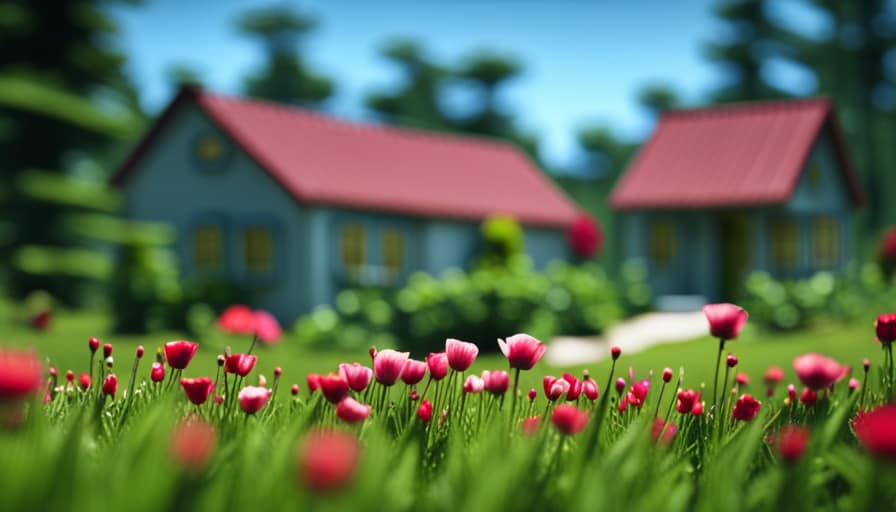I’ve come to understand the importance of efficient resource management as a resident of a tiny house.
One challenge I faced was disposing of grey water responsibly. It’s like trying to find a path through a dense forest without leaving a trace.
But fear not! Through extensive research and practical solutions, I’ve discovered effective ways to tackle this issue.
In this article, I’ll share my findings on how to dispose of grey water in a tiny house, so you can live sustainably and serve the environment with ease.

Key Takeaways
- Proper grey water disposal is important for maintaining hygiene and preventing health hazards in a tiny house.
- Grey water recycling is a crucial aspect of water conservation and reducing water usage.
- Understanding local regulations and restrictions is important to ensure proper grey water disposal and avoid potential consequences of improper disposal.
- Creative ways to repurpose grey water in a tiny house include using it for non-potable purposes such as flushing toilets, cleaning outdoor surfaces, and watering plants and gardens.
The Importance of Proper Grey Water Disposal
As a tiny house owner, I understand the importance of properly disposing of grey water. It isn’t only essential for maintaining hygiene and preventing health hazards, but it also plays a crucial role in water conservation.
One effective solution for grey water disposal is the use of composting toilets. Composting toilets offer numerous benefits, including reducing water usage and eliminating the need for traditional sewage systems. These toilets use a natural process to break down waste into compost, which can then be used as fertilizer for plants.
Understanding Grey Water and Its Environmental Impact
I’ve learned that grey water, which includes water from sinks, showers, and laundry, can have a significant environmental impact if not properly disposed of. Understanding the environmental impact of grey water is crucial in finding sustainable solutions.
Here are some key points to consider:

-
Grey water recycling techniques: Implementing techniques such as filtration, disinfection, and storage can help reuse grey water for non-potable purposes, reducing the strain on freshwater resources.
-
Grey water regulations and restrictions: It’s important to familiarize yourself with local regulations and restrictions regarding grey water disposal. This will ensure that you’re in compliance with the law and taking necessary precautions to protect the environment.
-
Environmental impact: Improper disposal of grey water can contaminate soil and water bodies, leading to nutrient pollution, algal blooms, and harm to aquatic ecosystems. By understanding the potential consequences, we can take steps to mitigate these impacts.
-
Importance of education and awareness: Spreading awareness about the environmental impact of grey water and promoting responsible practices can inspire others to adopt sustainable solutions.

Understanding the environmental impact of grey water is the first step towards finding effective solutions for its proper disposal.
Now, let’s explore the next topic: filtering and treating grey water for safe reuse.
Filtering and Treating Grey Water for Safe Reuse
One effective way to ensure the safe reuse of grey water in a tiny house is by filtering and treating it using a combination of techniques.
Grey water recycling is a sustainable solution that can help conserve water and reduce environmental impact.

When it comes to filtering methods, there are several options available. One common method is using a series of filters, such as sand filters or activated carbon filters, to remove impurities and contaminants from the grey water.
Additionally, treating the grey water with disinfectants like chlorine or UV light can further ensure its safety for reuse.
It’s important to note that proper maintenance and regular monitoring of the filtering and treating systems are crucial to ensure their effectiveness.
Creative Ways to Repurpose Grey Water in a Tiny House
I can repurpose grey water in my tiny house by using it to water my plants and garden. Here are some creative ways to make the most of grey water:

- Grey water storage solutions:
- Install a simple storage tank to collect and store grey water for later use.
- Use a bucket or container to collect grey water from sinks and showers.
- DIY grey water recycling systems:
- Set up a gravity-fed system to divert grey water from your sinks and showers to your garden.
- Build a filtration system using rocks, sand, and charcoal to remove impurities from the grey water.
- Use grey water for non-potable purposes:
- Use it to flush toilets, reducing water consumption.
- Use it to clean outdoor surfaces or wash your car.
Best Practices for Managing and Disposing of Grey Water in a Compact Living Space
To effectively manage and dispose of grey water in a compact living space, it’s important to follow proper guidelines and utilize appropriate systems.
One of the key aspects of grey water management is grey water storage. This involves collecting and storing grey water from sources such as sinks, showers, and washing machines for later use or disposal.
Grey water storage systems can range from simple buckets or barrels to more advanced tanks or containers with filtration systems. These storage systems help in preventing grey water from contaminating the environment and provide an opportunity for grey water recycling.
Grey water recycling involves treating and reusing grey water for non-potable purposes like watering plants or flushing toilets. This not only reduces water wastage but also promotes sustainability and conservation in a compact living space.

Frequently Asked Questions
Can I Use Grey Water for Drinking or Cooking Purposes?
No, it is not safe to use grey water for drinking or cooking purposes. Grey water contains contaminants that can pose health risks. There are various grey water treatment options available to ensure safe disposal.
What Are the Potential Health Risks Associated With Improper Grey Water Disposal?
Improper grey water disposal can lead to potential contamination and have a negative environmental impact. It is important to properly dispose of grey water to avoid health risks and protect the environment.
Is It Possible to Reuse Grey Water in a Tiny House Without Any Treatment?
Yes, it is possible to reuse grey water in a tiny house without treatment. However, it is important to consider the potential health risks associated with untreated grey water and implement proper grey water treatment methods for safety and hygiene.
Are There Any Specific Regulations or Guidelines for Grey Water Disposal in Compact Living Spaces?
There are specific regulations and guidelines for grey water disposal in compact living spaces. It is important to follow these guidelines to ensure proper and safe disposal of grey water in a tiny house.

Can I Use Grey Water for Watering My Vegetable Garden?
Sure, I can use grey water for my vegetable garden. It’s a win-win situation – I save water and my plants get nutrients. Just make sure to filter the grey water to remove any impurities.
Conclusion
In conclusion, proper disposal of grey water in a tiny house is essential for maintaining a sustainable and environmentally-friendly living space. By understanding the impact of grey water and implementing filtration and treatment methods, we can safely reuse this resource.
Additionally, finding creative ways to repurpose grey water can further maximize its utility in a compact living space. By following best practices and adopting a solution-oriented mindset, we can effectively manage and dispose of grey water, ensuring a clean and efficient living environment.
Remember, every drop counts!

I’m Theodore, and I love tiny houses. In fact, I’m the author of Tiny House 43, a book about tiny houses that are also tree houses. I think they’re magical places where imaginations can run wild and adventures are just waiting to happen.
While tree houses are often associated with childhood, they can be the perfect adult retreat. They offer a cozy space to relax and unwind, surrounded by nature. And since they’re typically built on stilts or raised platforms, they offer stunning views that traditional homes simply can’t match.
If you’re looking for a unique and romantic getaway, a tree house tiny house might just be the perfect option.










